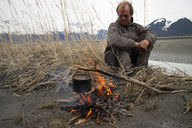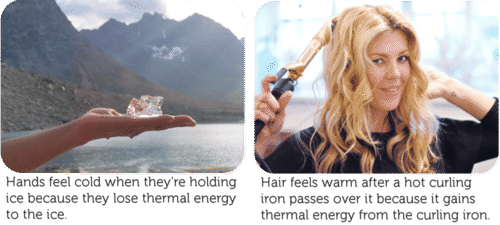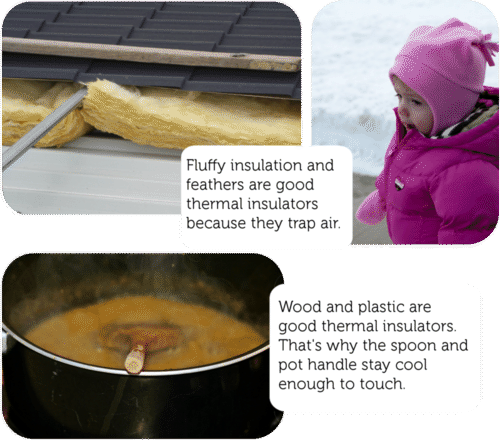1.4热能传递
Section outline
-
Lesson Objectives
::经验教训目标- Describe the conduction of thermal energy.
::描述热能的导电情况。
- Explain how convection transfers thermal energy. (Advanced Topic)
::解释对流如何转移热能。 (高级专题)
- Give an example of the radiation of thermal energy. (Advanced Topic)
::举一个热能辐射的例子。 (高级专题)
Lesson Vocabulary
::词汇表课程- conduction
::行为操动
- convection (Advanced Topic)
::对等(高级专题)
- convection current (Advanced Topic)
::对流当前(高级专题)
- thermal conductor
::热导热器
- thermal insulator
::热绝热器
Introduction
::导言Did you ever cook over a campfire? The man in Figure is cooking his lunch. He waits as his food absorbs energy. First, the energy from the fire needs to heat the water. Soon, all the water in the pot will be boiling hot. The man also feels warm. He feels the heat from the flames. He feels the warmth even though he is not touching the flames. Thermal energy is transferred from the fire to his hands.
::你曾经在营火中煮过饭吗?在图中的人在做午餐,他等待着食物吸收能量。首先,火的能量需要加热水。不久,锅里的所有水都会沸腾,他也会感到温暖。他感觉到火焰的热量。他感觉温暖,即使他没有触碰火焰,他也能感觉到温暖。热能从火中转移到他的手中。Thermal energy from the fire is transferred to the pot and water and to the man sitting by the fire. Conduction
::指挥You may know that electricity flows through wires. Wires are good conductors of electricity. Heat too can be transferred, or conducted, through some types of materials. The term conduction refers to the transfer of energy. Conduction occurs when energy is passed between objects.
::你也许知道电流是通过电线进行的。电线是良好的电力导体。热能也可以通过某些类型的材料来转移或进行。电能的传导是指能源的传导。当能量在物体之间传递时,电能就会发生作用。The transfer of thermal energy is called heat . Particles of matter are in constant motion. Sometimes they collide with other particles. When they do, they transfer some of their energy. The energy is transferred from particle to particle. It is sort of like a row of dominoes falling over. In this process, thermal energy moves through a substance. It can even move into other nearby substances.
::热能的转移被称为热能。 物质粒子在不断运动中。 有时它们与其他粒子相撞。 当它们相撞时, 它们会转移一些能量。 能量会从粒子转移到粒子。 有点像一排多米诺落下。 在此过程中, 热能会通过物质移动。 它甚至可以转移到附近的其他物质中 。In Figure , conduction occurs between particles of the metal in the pot. It also occurs between particles of the pot and the water. Figure shows additional examples of conduction.
::在图4中,金属在锅中的粒子之间发生导电,在锅中和水中的粒子之间也发生导电,图5显示了其他导电的例子。How is thermal energy transferred in each of these examples? Thermal Conductors
::热导体Have you ever walked on hot pavement? Perhaps you jumped onto the grass to escape the heat? Why did the grass seem cooler? The grass and pavement are both in the Sun? Maybe it has to do with how well they conduct energy.
::你曾经走过热路吗?也许你跳上草坪以躲避热浪?为什么草坪看起来更凉爽?草坪和人行道都在太阳中?也许这与他们如何掌握能量有关。Think about a cooking utensil. Have you noticed some have wood or plastic handles? Do you know why? Think about the grass and the pavement on that sunny day.
::想想一个烹饪用管。 你有没有注意到一些有木或塑料把手?知道为什么吗?想想那个阳光明媚的日子的草和人行道。It's all about the type of matter. Some types of matter are good at allowing heat to flow through them. Other types of matter, or materials, are good insulators. They resist the flow of heat through them, meaning they are not good conductors of heat.
::这都是关于物质的类型。 某些类型的物质可以让热能通过它们。 其他类型的物质,或者材料,都是很好的绝缘器。 它们抵制热能通过它们, 意思是它们不是热的导体。Materials that are good conductors of heat are called thermal conductors . Metals allow heat to flow through them easily. That’s why the metal pot in the Figure quickly gets hot all over. This happens even if the fire is only at the bottom of the pot. The heat moves easily throughout the metal pot. The pot is able to get hot all over. It doesn't just get hot on the bottom. In Figure , the curling iron heats up almost instantly. It is able to transfer thermal energy to the strands of hair that it touches.
::热导体良好的材料被称为热导体。 金属可以让热流很容易地穿透它们。 这就是为什么图中的金属锅很快会变得热。 即便火只在锅底, 热量也很容易移动。 热量可以让整个金属锅都变得热。 热量不能让锅在底部变得热。 图中, 弯曲的铁几乎可以瞬间发热。 它能够将热能转移到它所触及的毛发线上。Thermal Insulators
::热绝热器Some materials are able to resist the transfer of heat. These materials are poor conductors of heat. Therefore, they are called thermal insulators . Figure shows several examples. Fluffy yellow insulation inside the roof of a home is full of air. The air prevents the transfer of thermal energy. In air (a gas) the molecules are further apart. The transfer of heat is much more difficult. Again, think about that row of dominoes. If they are close together and they start to fall, the motion is quick. If they are placed further apart, the falling motion is slower. You can try this by having some domino races.
::某些材料可以抵抗热传输。 这些材料是低导体的热导体。 因此, 它们被称为热绝缘器。 图显示了几个例子。 家庭房顶内毛黄色绝缘是充满空气的。 空气防止热能传输。 在空气中, 分子会进一步分离。 热转移要困难得多。 再说一遍, 想想那排多米诺人。 如果它们相近, 开始下降, 运动会很快。 如果它们被进一步分开, 下降的动作会更慢。 您可以通过一些多米诺人比赛来尝试这一点 。For the same reason, house insulation keeps the heat out of the house on hot days and in the house on cold days. The trapped air (a gas) is slow to transfer thermal energy. A puffy down jacket keeps you warm in the winter for the same reason. Its feather filling holds trapped air. The trapped air prevents energy transfer from your warm body to the cold air outside. Solids like plastic and wood are also good thermal insulators. That’s why pot handles and cooking utensils are often made of these materials.
::出于同样的原因,房屋绝缘使室内热热日不热,寒日不热。被困空气(气体)转移热能的速度较慢。被困空气(气体)使热能转移的速度较慢。 被困的夹克使您在冬天也因为同样的原因保持了温暖。 羽毛填充使空气被困住。 被困空气阻止能源从温暖的身体转移到外面的冷空气中。 塑料和木材等固体也是很好的热绝缘器。 这就是为什么锅柄和炊具往往由这些材料制成。Thermal insulators have many practical uses. Can you think of others? Convection (Advanced Topic)
::对话(高级专题)Convection is another way thermal energy is transferred. In convection, heat is transferred by particles moving through a fluid. Heat is transferred from warmer to cooler areas. That’s how energy is transferred in the soup in Figure . Particles of soup near the bottom of the pot get hot first. They have more energy so they spread out and become less dense. With lower density, these particles rise to the top of the pot (see Figure ). By the time they reach the top of the pot, they have cooled off. They have less energy to move apart. As a result, they become more dense. With greater density, the particles sink to the bottom of the pot. The cycle repeats over and over again. This loop of moving particles is called a convection current .
::热能的转移是另一种方式。在对流中,热能通过流体的粒子转移。热能从温暖地区转移到冷却地区。热能从温暖地区转移到冷却地区。这就是如何在图中汤中转移能量的方式。汤汤在锅底附近的粒子首先变得热。它们有较多的能量,因此它们会扩散,变得更低密度。随着密度的降低,这些粒子会升到锅顶部(见图 ) 。当它们到达锅顶部时,它们已经冷却下来了。因此,它们会变得更稠密。随着密度的增加,粒子会沉到锅底。循环会反复重复。这种移动粒子的循环被称为对流。Convection currents carry thermal energy throughout the soup in the pot. Convection currents move thermal energy through many fluids. Heat is transferred though molten rock (a semi-liquid) inside the Earth. Water in the oceans circulates because of this process. Even the air in the atmosphere transfers heat in this way. In the atmosphere, convection currents create wind. You can see one way this happens in Figure . Land heats up and cools off faster. Therefore, land is warmer during the day and cooler at night than water. Air close to the surface gains or loses heat as well. Warm air rises because it is less dense. When it does, cool air moves in to take its place. This creates a convection current that carries air from the warmer to the cooler area.
::对流流流通过许多流体移动热能。 热能通过熔岩( 半液态) 迁移到地球内部。 海洋中的水会因为这个过程而循环。 即使大气中的空气也会以这种方式传播热量。 在大气中, 对流流流会产生风。 您可以在图中看到这种情况。 陆地会上升, 冷却得更快。 因此, 白天土地会变暖, 晚上会比水更冷。 接近地表的空气会增加, 或者会失去热量。 热气会上升, 因为温度会降低。 当它变暖时, 空气会凉爽地移动到它的位置。 这会产生一种对流, 将空气从暖气带到冷却区。A sea breeze blows toward land during the day, and a land breeze blows toward water at night. Why does the wind change direction after the sun goes down? Radiation (Advanced Topic)
::辐射(高级专题)Both conduction and convection transfer energy through matter. Radiation is the only way of transferring energy that doesn’t require matter. Radiation is the transfer of energy by waves. These waves can travel through empty space. When these waves reach objects, they transfer energy to the objects. This causes them to warm up. This is how the Sun’s energy reaches Earth and heats its surface (see Figure ). Radiation is also how thermal energy from a campfire warms people nearby. You might be surprised to learn that all objects radiate thermal energy. This even includes you. In fact, when a room is full of people, it may feel noticeably warmer. This is because of all the thermal energy the people radiate!
::电流和对流通过物质转移能源。辐射是转移能源而不需要物质的唯一方法。辐射是波浪的能量转移。这些波浪可以在空空空空间中移动。当这些波浪到达物体时,它们会将能源转移到物体身上。这使他们暖和起来。这就是太阳的能量如何到达地球并加热其表面(见图 ) 。辐射也是来自营火的热能如何使附近的人民温暖起来。你可能会惊讶地知道所有物体都辐射热能。这甚至包括你。事实上,当一个房间满是人时,它可能会感到更暖和。这要归功于人们的热能。Earth is warmed by energy that radiates from the sun. Earth radiates some of the energy back into space. Greenhouse gases (GHGs) trap much of the re-radiated energy, causing an increase in the temperature of the atmosphere close to the surface. Lesson Summary
::经验教训摘要- Conduction is the transfer of thermal energy. It occurs between objects or substances that are touching. Thermal conductors are materials that are good conductors of heat. Thermal insulators are materials that are poor conductors of heat. Both conductors and insulators have important uses.
::热导体是热能的转移,在触碰的物体或物质之间发生,热导体是热导体良好的材料,热导体是热导体差的材料,导体和绝热器都有重要的用途。
- Convection is the transfer of thermal energy. This occurs as particles move within a fluid. The fluid may be a liquid or a gas. The particles within the fluid transfer energy by moving from warmer to cooler areas. They move in loops. These loops are called convection currents.
::对流是热能的传输。当粒子在流体中移动时,就会发生这种情况。流体可以是液体或气体。流体中的粒子通过从温暖区向冷却区移动来转移能量。它们以循环方式移动。这些循环被称为对流流。
- Radiation is the transfer of thermal energy by waves. These waves can travel through empty space. When the waves reach objects, the heat is transferred to the objects. Radiation is how the Sun warms the Earth's surface.
::辐射是热能通过波浪传输的热能。 这些波浪可以穿行于空空空空间。 当波浪到达物体时, 热量会转移到物体身上。 辐射是太阳如何温暖地球表面的。
Lesson Review Questions
::经验回顾问题Recall
::回顾- Define conduction.
::定义操控。
- Define convection.
::定义对流。
- Define the radiation of thermal energy.
::界定热能的辐射。
Apply Concepts
::应用概念- Fill in each blank in the diagram below with the correct method of heat transfer.
::以正确的传热方法填充下图中的每个空白。
- How could you insulate an ice cube to keep it from melting? What material(s) would you use?
::如何使冰块绝缘以防止融化?你会使用什么材料?
Think Critically
::仔细仔细思考- Why does convection occur only in fluids?
::为什么对流只发生在液体中?
- A friend tells you that insulation keeps out the cold. Explain why this statement is incorrect. What should your friend have said?
::一位朋友告诉你绝缘可以避免寒冷,请解释为什么这种说法不正确。你的朋友应该说什么?
Points to Consider
::需要考虑的要点Thermal energy is very useful. For example, we use thermal energy to keep our homes warm and our motor vehicles moving.
::热能非常有用,例如,我们利用热能来保持家居温暖和机动车辆的移动。- How does thermal energy heat a house? What devices and systems are involved?
::房屋的热能如何加热?涉及哪些装置和系统?
- How does thermal energy run a car? How does burning gas in the engine cause the wheels to turn?
::发动机中燃烧气体如何导致轮子转弯?
- Describe the conduction of thermal energy.






